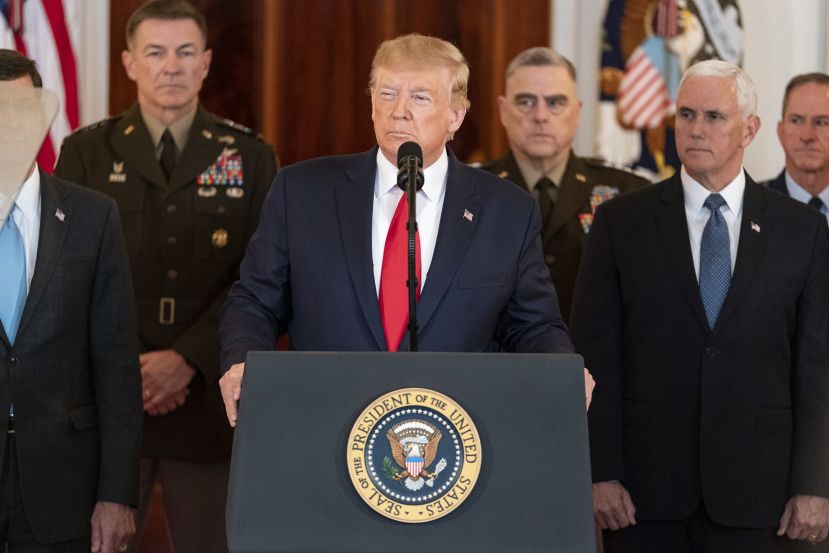10 Takeaways from President Trump's Action Against Iran
- Written by Ali Cinar
- Published in TOA Authors
I was at the White House during President Trump’s address to the nation last week after the retaliatory attacks by Iran on bases in Iraq housing U.S. soldiers. President Trump explained the reason why the U.S. military killed Soleimani and also shared the details of the new sanctions against Iran.
Let’s look at the takeaways from the President’s action against Iran.
Iran’s Missile Attacks and No Casualties
President Trump said, “There were no Americans harmed by the Iranian regime missiles attack. We suffered no casualties. All of our soldiers are safe, and only minimal damage was sustained at our military bases.” He also explained that no American or Iraqi lives were lost because of the precautions taken, the dispersal of forces, and an early warning system that has worked very well. President Trump saluted the incredible skill and courage of America’s men and women in uniform.
Iraqi Prime Minister Mahdi made a statement that Iran Administration has sent Iraq an official message that missile attacks “had begun or would begin shortly,” on unspecified U.S. military locations. It was believed that the Iraqi government officials gave a warning to the U.S. on “which bases would be targeted” after Iranian officials passed on the information.
U.S. Troops Staying In Iraq
Despite Iraq's Parliament voted U.S. troops out,United States has no plans to withdraw troops from Iraq. State Department Spokesperson, U.S. sees Iraq as a strategic partner not just on security but security, on financial, economic, and diplomatic partnerships. The U.S. wants to be a Friend to a sovereign, prosperous, and stable Iraq. U.S. troops are located at nine different bases and number 5200 soldiers. They, including contractors and subcontractors, remained in Iraq to help local forces contain ISIS and stop Iran’s influence in the region.
The Iraqi Parliament asked the U.S. for a pullout plan. After Trump’s decision to kill Soleimani, the future of the U.S. presence in the Middle East is not bright.
Secretary of State Pompeo and Secretary of Defense Esper made clear statements that U.S. military presence will continue in Iraq.
Is the U.S. ready to embrace peace with all who seek it?
President Trump called to the people and leaders of Iran: “We want you to have a future and a great future—one that you deserve, one of prosperity at home, and harmony with the nations of the world. The U.S. is ready to embrace peace with all who seek it.”
It was seen as a positive message to reduce tension. At the same time, U.S. Ambassador to United Nations Kelly Craft sent a letter to the UN Security Council, offering to prepare to engage without preconditions in serious negotiations with Iran to prevent further endangerment of international peace and security or escalation by the Iranian regime.
Global Actors Urged to Pull Out of a Nuclear Agreement
President Trump made a new proposal and stated that the U.S. is “ready for a new and better” nuclear agreement with Iran. He also blamed President Obama for the 2015 Iran deal, which sought to limit Iran’s capability to establish a nuclear weapon in exchange for the lifting of financial sanctions.
President Trump also said: “As long as I am President of the U.S., Iran will never be allowed to have a nuclear weapon.” He added: “Iran must abandon its nuclear ambitions and end its support for terrorism. The time has come for the UK, Germany, France, Russia, and China to recognize this reality.”
NATO’s Presence in the Middle East
President Trump asked NATO Secretary-General about giving more contributions in Iraq. He also suggested that NATO establish a NATO-ME (Middle East) Unit in the region.
A small NATO training division in Iraq suspended its activities during Iran’s missile attack. Secretary-General has also condemned the Iranian missile attacks on the U.S. and the coalition forces in Iraq. NATO called on Iran to refrain from further violence.
The Secretary-General will be meeting with the Deputy Minister of Foreign Affairs of Iraq, Mr. Abdul Karim Hashim Aboualgus, at the NATO Headquarters on January 14th.
The U.S. introduced new sanctions on Iran.
Secretary of State Mike Pompeo and Treasury Secretary Mnuchin announced new sanctions on Iran's metal exports and eight senior Iranian officials at the exclusive White House Press Briefing.
Trump Administration is evident in the continuation of sanctions against Iran. "Today's sanctions are part of our commitment to stop the Iranian regime's global terrorist activities," said Secretary Pompeo.
Unexpected Demonstrations in Iran
Protests and teargas as public anger grow over Ukranian aircraft downing. Iran is facing a new crisis over the Iranian military's shooting down of a commercial airliner with 176 people on board.
Thousands of Iranians chanted during demonstrations against President Rouhani and Ali Khamenei in protest against unemployment, poverty, and the high cost of living in the past months.
Ukranian Plane Crash in Iran
Iranian ballistic missiles shot down the Ukranian plane after Iran launched strikes on Iraqi bases housing U.S. troops. First, Iranian officials have rejected allegations that they tried to orchestrate a cover-up; however, Iran has admitted it unintentionally shot down a Ukrainian passenger jet, blaming human error and the U.S.
There are also questions as to why Iran let a commercial flight take off during the airstrikes.
Two official statements came from Canada and Ukraine. Canadian Prime Minister Justin Trudeau said, “We will not rest until there are justice and accountability,” and Ukraine President called for the perpetrators to be held accountable.
War Powers Resolution-Democrats
The U.S. House of Representatives voted to limit Trump’s military action against Iran without Congressional approval and rebuked the president over his use of military power in the Middle East.
The vote was 224-194, and 8 Democrats voted against the resolution.Senator Tim Kaine proposed a similar resolution that is expected to be discussed this week.
Pompeo and Cavusoglu speak during the tensions.
Secretary Pompeo has spoken with his Turkish counterpart a few times during the about the tensions between the U.S. and Turkey. Turkish officials emphasized the need to work with other countries to solve the problem or de-escalate tensions between the U.S. and Iran.
President Erdogan also shared his concerns about the crisis and highlighted, “Nobody has the right to throw the entire region, especially in Iraq, into a ring of fire for the sake of his or her interests.”
As a result, the United States and Iran crisis has calmed down; however, many things won't be the same as how they were before.
Trump administration will continue pressure on Iran with the military presence in Iraq and Syria as well as economic sanctions. The question is how and till when Iran will resist the significant demand from U.S. and NATO Allies.
Iran's reputation is getting worse after shooting down the commercial plane, killing 176 innocent people.
There is one reality that Iranian General Soleimani was a terrorist and responsible for killing U.S. troops and innocent people in Syria. Soleimani was reportedly by Turkish and many ethnic media outlets that he was a point person for Iran's backing of Syrian President Assad and helped shape the Syrian military strategies in a terrible civil war that began with pro-democracy protests in 2011.
Although Democrats remain unconvinced, Soleimani threat was imminent, even many Syrian and Turkish people believe that he was a significant threat to the region.
2020 is a presidential election year; however, the foreign policy should be a significant focus for Trump administration this year.
Let's see how the future will look with NATO's further involvement in Iraq.
Related items
Latest from Ali Cinar
- Merve Hickok, President of the Center for AI and Digital Policy, speaks on the latest developments in AI.
- Bloomberg HT U.S. Representative Ali Cinar interviews Julie Ediah, U.S. Consul General of Istanbul
- Integrated Polymer Industries Recognized by Northrop Grumman for Supplier Excellence
- Cuts to Social Work and Education Budgets in New York
- President Biden meets with Texas governor, officials in 1st visit to US-Mexico border










